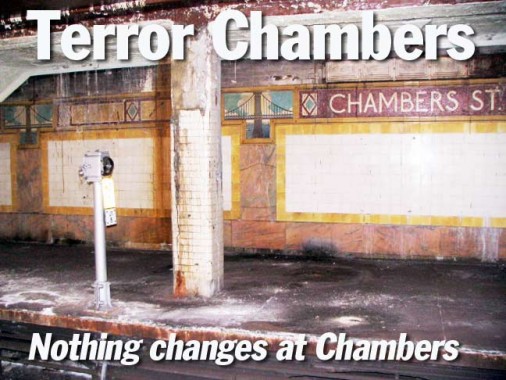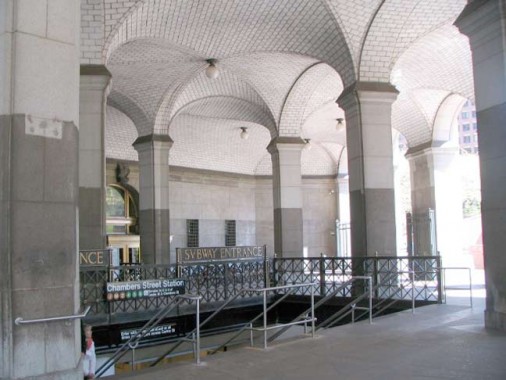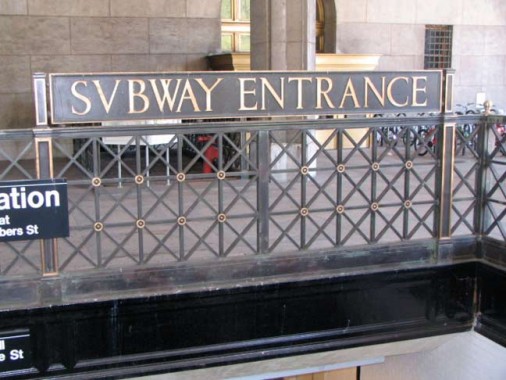In 2003 I did a series of photographs for a page on the BMT Chambers Street station, the original southern terminal of what is today the J train that runs from Broad Street to Jamaica via the Williamsburg Bridge. However, what had been an important terminal experienced a change in fortunes when tracks were extended to connect with the BMT Broadway Line in 1931:
In 1931, the Nassau Street subway loop was completed, making Chambers St. a through station south to the Montague Street tunnel to Brooklyn. It was about this time that the center platform and the side platforms were closed as excessive. The west side platform was walled up and partly destroyed when the IRT station was rebuilt on the other side of the wall in 1960-1962. All of these areas are still visible in plain sight from the open platforms. nycsubway
Chambers Street station, in its early days, also served as a terminal for Long Island Rail Road trains via a connection from the Jamaica el in Cypress Hills. That connection, though, was shut down by 1917. In the post-9/11 planning frenzy, there were wild tales about extending the LIRR from its Flatbush Avenue terminal to the planned new WTC. In those news reports, though, it wasn’t mentioned that once upon a time, a LIRR connection to Downtown Manhattan did once exist.
In addition, the connection Chambers Street had with the Manhattan Bridge until 1967 was eliminated when a new Chrystie Street connection was made to enable 6th Avenue Line IND trains to cross the Manhattan Bridge, as well as trains from eastern Brooklyn and Queens to use the Williamsburg Bridge and run up 6th Avenue.
Oh, how the mighty have fallen! With two platforms closed, the Chambers Street station now resembles a moldy mausoleum…
The entrance to the BMT under the Municipal Building is grand, compared to what you see once you get down there, with elegant vaulting. The entrance also provides access to the Lexington Avenue IRT 4, 5, 6.
Sculptors in the days of the Roman Empire commonly carved the letter U with a pointed edge; their alphabet did not distinguish between the two letters U and V, which only became separate entities in the Middle Ages. That was when the letter W appeared as well. Modern day sculpture lettering sometimes attempts to impart an air of gravitas by rendering the U’s as V’s. For years enamel signs at Queensborough Plaza said” QVEENSBOROVGH. I wish I had gotten photos of those.
The Chambers Street station was among the first underground stations built by Brooklyn Rapid Transit, the predecessor of the BMT (Brooklyn-Manhattan Transit). Hence, the stations under Centre Street, Chambers, Canal, and Bowery, look somewhat different from the BMT stations that followed it. The BMT used a diamond pattern in sstation art, but here it shows up on the ID plaques as well as sanserif lettering. Beginning later in the 1910s, the BRT/BMT would shift to serifed letters, which in turn reverted back to sanserif with the IND in the 1930s. The pink marbled pattern, used a lot in early IRT construction, shows up here as well, but it was pretty much abandoned after this.
The beautiful ceramic plaque is supposed to depict the Brooklyn Bridge — Chambers Street was originally called the Brooklyn Bridge station. Original schematics depicted the bridge rendered without its trademark diagonal cables, and that was carried through when the ceramics were manufactured. Also shown are a couple of boats, billowing clouds, the Statue of Liberty and the hills of Staten Island beyond.
A close-up of the no nonsense sanserif lettering on the ID tablet which is rendered in subtle browns and golds.
The condition of the abandoned platforms is truly shocking — this isn’t in outlying Brooklyn or Queens, but directly under the Municipal Building and across the street from City Hall. The City’s reckoning must be, why throw money at platforms that are unused. However, as this station approaches its centennial, a cleanup would be nice.
4/10/12


